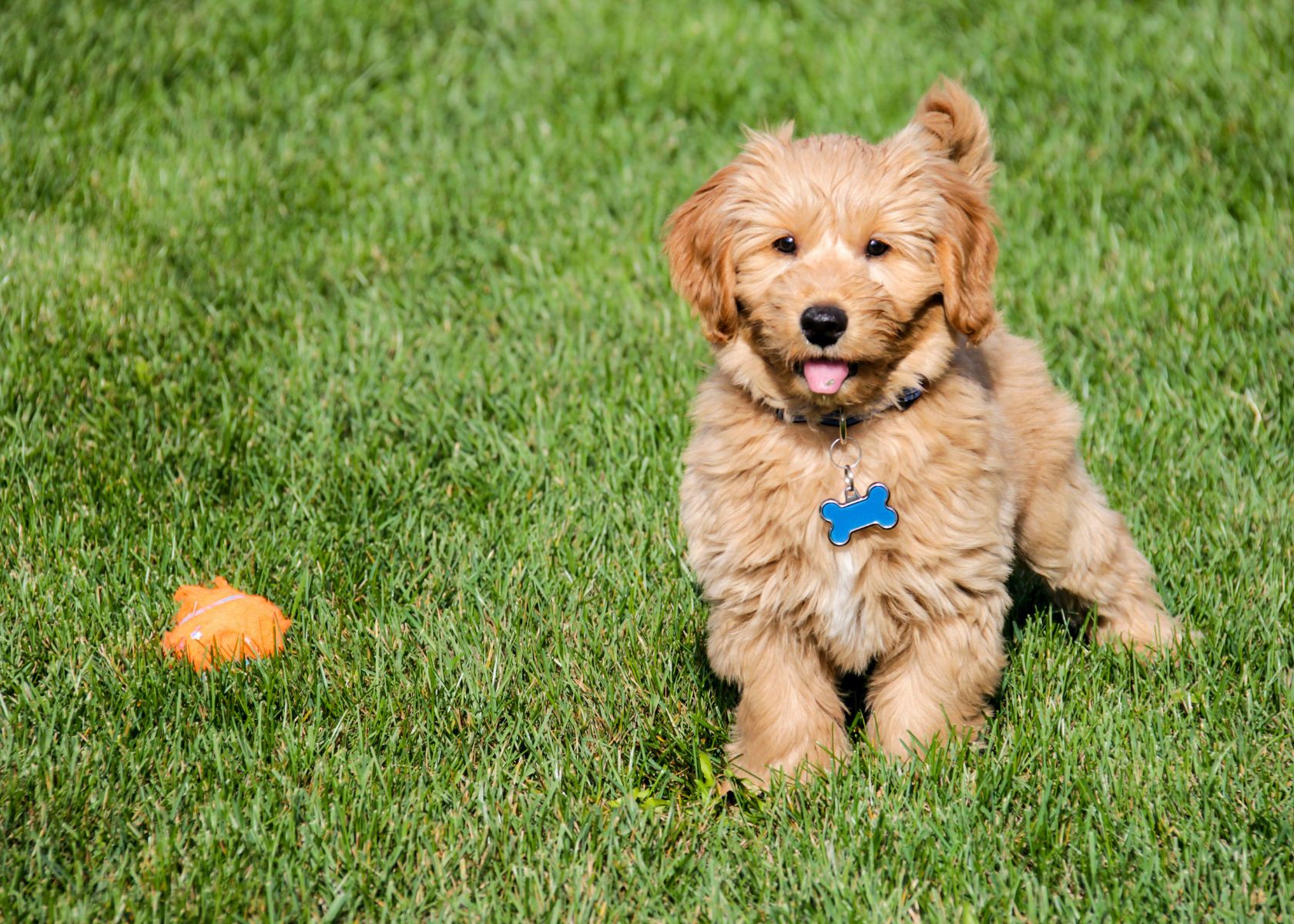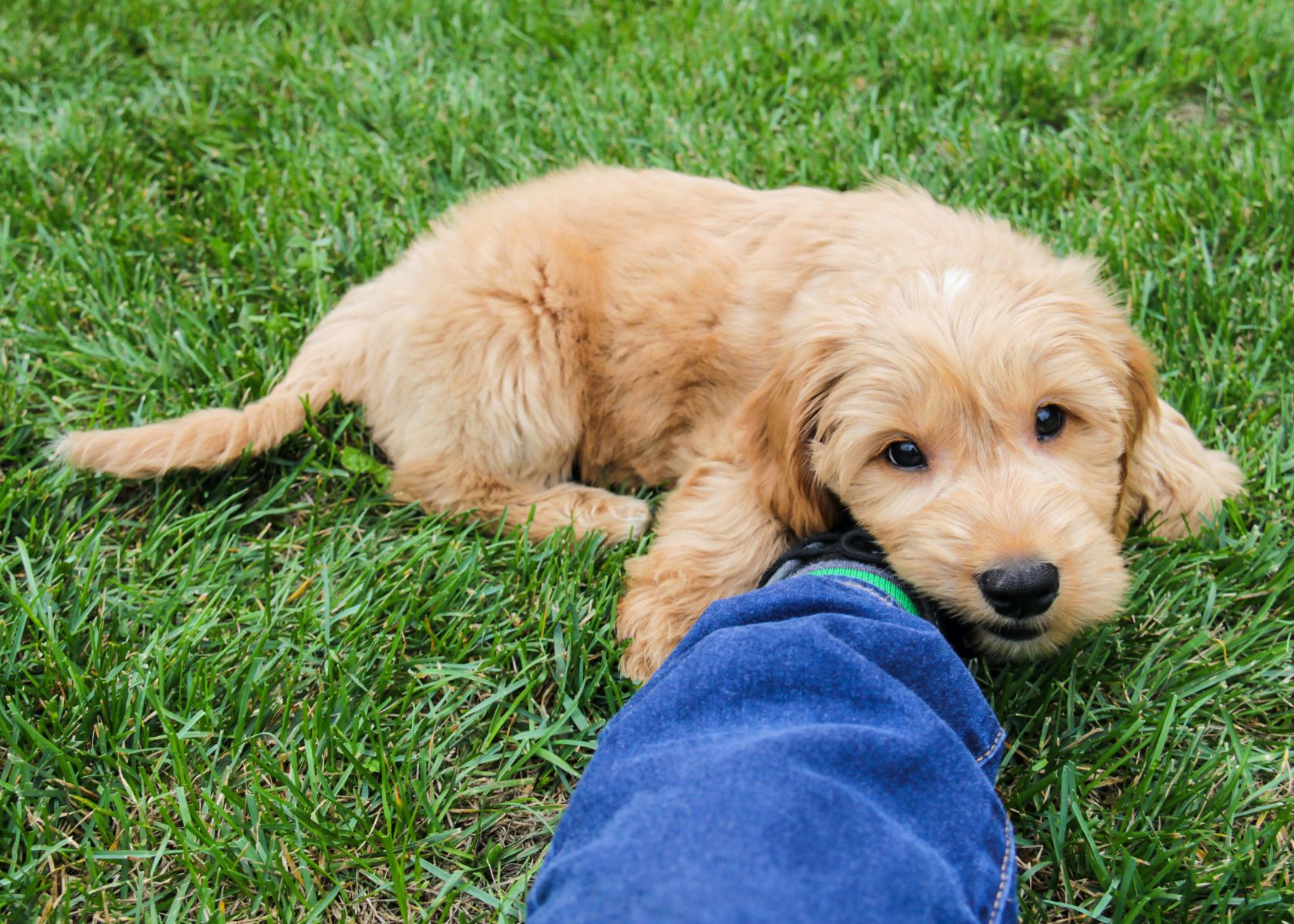What Age Do Goldendoodles Calm Down? Goldendoodle Calming Tips
Ever catch yourself repeatedly wondering, “What age do Goldendoodles calm down?” You’re not alone – I’ve spent a fair share of time wrestling with the same query. Speaking from first-hand experience and relentless investigations into this breed’s behavior patterns, these lively pooches can indeed test your patience levels.
I have written this article to offer some solace by providing insights into typical Goldendoodle behavioral stages, clues that indicate they have excess energy, strategies to help curb their hyperactivity, and when you might begin to spot significant transformations.
So grab your reading glasses (and maybe some coffee) as we navigate this enlightening journey together.
Goldendoodle Behavior Stages

Goldendoodle behavior progresses through several distinct stages, including early puppyhood, late puppyhood, adolescence, and finally adulthood.
Early Puppyhood
In the early puppyhood stage, Goldendoodles are bursting with energy. This behavior is typical, as it’s their way of exploring and understanding their surroundings. They can be quite the handful with their ceaseless desire to play, coupled with an endearing but sometimes annoying habit of biting everything in sight.
This phase also marks a critical period for socialization and exposure to new experiences, which helps shape a doodle into a well-rounded adult. Begin training at this stage by incorporating simple commands into playtime sessions.
Regular exercise is crucial, too; it helps handle those surplus energy levels while promoting good health and development. Don’t expect calmness during this time; your frisky furry friend will remain active until they smoothly transitions out of this lively phase towards late puppyhood.
Late Puppyhood
During late puppyhood, Goldendoodles are still in the process of developing their behavior and transitioning into adulthood. This stage generally occurs between 12 to 18 months of age.
While they may start to calm down during this time, it’s important to keep in mind that there won’t be a sudden change in their energy levels. Instead, you’ll notice a gradual decrease as they mature.
Remember, every Goldendoodle is different, so some may take longer to calm down than others. Providing them with proper training and exercise will help them navigate through this stage and become calmer overall.
It’s also worth noting that even after they’ve calmed down, Goldendoodles might still display some puppy-like behavior from time to time.
In terms of energy levels, regular exercise and mental stimulation play significant roles in calming your Goldendoodle during late puppyhood. By engaging them physically and mentally through activities such as walks, playtime, puzzle toys, or obedience training sessions, you can help channel their energy toward positive outlets.
Adolescence
During adolescence, Goldendoodles go through a period of transition from puppyhood to adulthood. This stage typically occurs between 12 and 18 months of age. While they may still have bursts of energy, their overall energy levels gradually decrease during this time.
It’s important to provide consistent training and exercise to help them navigate this phase. Although they may still display some puppy-like behavior, Goldendoodles will begin to exhibit more maturity and calmness as they enter adulthood.
Adulthood
During the adulthood stage, Goldendoodles start to calm down and become more settled compared to their puppyhood years. This typically occurs between 12-18 months of age when they are transitioning from the puppy phase into adulthood.
While there won’t be a sudden change in their energy levels, Goldendoodles’ overall energy will gradually decrease over time. Although some dogs may take longer to calm down than others, providing consistent training and regular exercise can help them achieve a calmer state.
It’s important to note that even after they calm down, Goldendoodles may still display occasional bursts of energy and exhibit some puppy-like behavior. Nevertheless, with proper care and mental stimulation, you can help your Goldendoodle become a well-behaved adult companion.
Signs of So Much Energy in Goldendoodles

Goldendoodles can exhibit signs of hyper energy through excessive energy, destructive behavior, and boredom. Find out how to help calm your Goldendoodle in the next section.
Excessive Energy
Goldendoodles can be full of energy, especially during their puppy stages. They may have bursts of unlimited energy that seem never-ending. They may bark a lot because the Goldendoodle energy level is exploding in the early years. It’s not uncommon for them to be constantly running around, jumping on furniture, or playing with anything they can find.
This excessive energy can sometimes lead to destructive behavior and make it challenging to keep up with your poodle. However, as Goldendoodles mature and transition into adulthood between 12 and 18 months old, their excessive energy tends to subside gradually.
While they may still have moments of high activity levels, overall, they become calmer and more manageable companions. To help in the process of calming down your Goldendoodle, regular exercise and mental stimulation are essential factors to consider.
Destructive Behavior
Goldendoodles may exhibit destructive behavior, especially during their puppy stages and adolescence. This includes chewing on furniture, shoes, or other household items, digging up the yard, or scratching doors and walls.
This behavior is often a result of pent-up energy and boredom. Regular exercise and mental stimulation can help redirect their energy in more positive ways. Proper training is also crucial in teaching them appropriate behaviors and providing them with structure.
It’s important to remember that while most Goldendoodles will calm down between 12-18 months of age, some may take longer to reach this stage. It is not like all Goldendoodle puppies are so energetic because some Goldendoodle owners say that theirs are calm down.
Boredom
Goldendoodles can become bored easily, and this can contribute to their pent-up energy. When they are not properly stimulated mentally or physically, they may start exhibiting destructive behavior or excessive energy.
It is important to address their boredom by providing them with regular exercise and mental stimulation. Interactive toys, puzzle games, and training sessions can help keep their minds engaged and prevent boredom.
You can use a chew toy for your golden retriever mix breed or maybe incorporate scent training for positive reinforcement in your doodle puppy. Take your puppy to a dog park and introduce it to some other dog breeds.
By keeping your Goldendoodle entertained and mentally stimulated, you can help them stay calm and focused.
Ways to Help Calm Your Goldendoodle

To help calm your Goldendoodle, you can provide regular exercise, engage in mental stimulation activities, implement training techniques, and try new activities to keep them mentally and physically stimulated.
The manic behavior and undesirable behavior in your Goldendoodle can be controlled using some calming techniques. Let’s take a look at how to calm down a Goldendoodle puppy.
Regular Exercise
Regular exercise is essential for helping your Goldendoodle calm down. By providing them with daily physical activity, you can help burn off excess energy and prevent destructive behavior.
Take your Goldendoodle for walks, play games of fetch, or engage in other types of active play that they enjoy. Regular exercise not only tires them out physically but also helps to stimulate their minds, which can contribute to a calmer demeanor overall.
Remember to tailor the exercise routine to your Goldendoodle’s age and health needs, gradually increasing the intensity as they grow older and stronger.
Mental Stimulation
Mental stimulation is an important aspect of helping your Goldendoodle calm down. Engaging their minds can help tire them out and reduce pent-up energy. You can provide mental stimulation through interactive toys, puzzle games, and training exercises.
Teaching your Goldendoodle new tricks or commands can also keep their brains active and focused. Remember, mental exercise is just as important as physical exercise in promoting calm behavior in your furry friend.
Training
Training plays a crucial role in helping your Goldendoodle calm down. By providing consistent and positive training, you can teach them how to behave appropriately and manage their energy levels effectively.
This includes basic obedience training, such as sit, stay, and come commands, as well as more advanced commands like “leave it” or “settle.” Through training sessions that involve mental stimulation and problem-solving activities, you can help redirect their pent-up energy into constructive behaviors.
Remember that while training is important for calming down your Goldendoodle, it’s also an opportunity to bond with them and strengthen your relationship.
Trying New Activities
Trying new activities can be a great way to help calm your Goldendoodle. It keeps their mind engaged and prevents boredom, which can lead to excessive energy and destructive behavior.
Introducing your Goldendoodle to different activities such as agility training, puzzle toys, or even swimming can provide mental stimulation and help them burn off excess energy. Remember that each dog is unique, so it may take some trial and error to find the activities that they enjoy the most.
However, experimenting with new experiences will not only keep your Goldendoodle entertained but also contribute to their overall well-being.
When to Expect Your Goldendoodle to Calm Down?

Typically between 12-18 months, but every dog is different. Read on to learn more about the factors that influence your Goldendoodle’s behavior and how you can help them find their calm.
Typically Between 12-18 Months
Most Goldendoodles will reach a calmer state between the ages of 12 and 18 months. This is when they transition from the puppy stage to adulthood, and their energy levels gradually decrease over time. Even after when they lose their puppy teeth, they can still be so much energetic.
While there won’t be a sudden change in their energy levels, Goldendoodles will overall become more relaxed. However, it’s important to note that some dogs may take longer to calm down than others.
Providing them with proper training and regular exercise can help in this process. Even after they calm down, Goldendoodles may still display some puppy-like behavior at times. Overall, expect your Goldendoodle to become calmer as they enter the adult stage of their life.
Every Dog Is Different
Each Goldendoodle has its own unique personality and temperament, which means that every dog will have different behaviors and timelines for calming down. While most Goldendoodles start to calm down around 12-18 months of age, some may take longer or shorter periods of time.
It’s important to remember that each dog matures at their own pace. So, be patient and provide the necessary training and exercise to help your Goldendoodle on their individual journey towards a calmer state.
Frequently Asked Questions
At what age do Goldendoodles usually start to calm down?
Goldendoodles often begin calming down as they reach maturity, typically around their first year, but this can vary depending on their specific personality and exercise needs.
What changes in behavior can I expect as my Goldendoodle grows older?
As Goldendoodles grow older, you can expect a decrease in puppy biting and out-of-control behavior, along with an increase in obedience due to successful Goldendoodle training.
Can training help my hyperactive goldendoodle calm down sooner?
Yes! Effective Goldendoodle training and socialization from a young age can significantly alter the timing and speed of the calming-down process in your pet’s behavioral development.
Are there any negative aspects if I don’t wait for my Goldendoodle to naturally calm down with age?
If your Goldendoodle remains high-energy longer than desired, it might lead to regretting getting a Goldendoodle due to increased chances of damage from uncontrolled energy levels or potential challenges with obedience training.
Do mini Goldendoodles behave differently than regular-sized ones when it comes to calming down?
Mini Goldendoodles generally follow the same pattern as their larger counterparts regarding age-related temperament changes; however, individual temperaments may bring some variability.
Conclusion
Goldendoodles typically start to calm down around 12-18 months of age as they transition from the puppy stage into adulthood. While their energy levels won’t drastically change all at once, they will gradually decrease over time.
It is important to provide them with proper training and exercise to help them calm down. Despite this, some Goldendoodles may take longer than others to reach a calmer state. Remember that even after they calm down, they may still display some puppy-like behavior occasionally.




